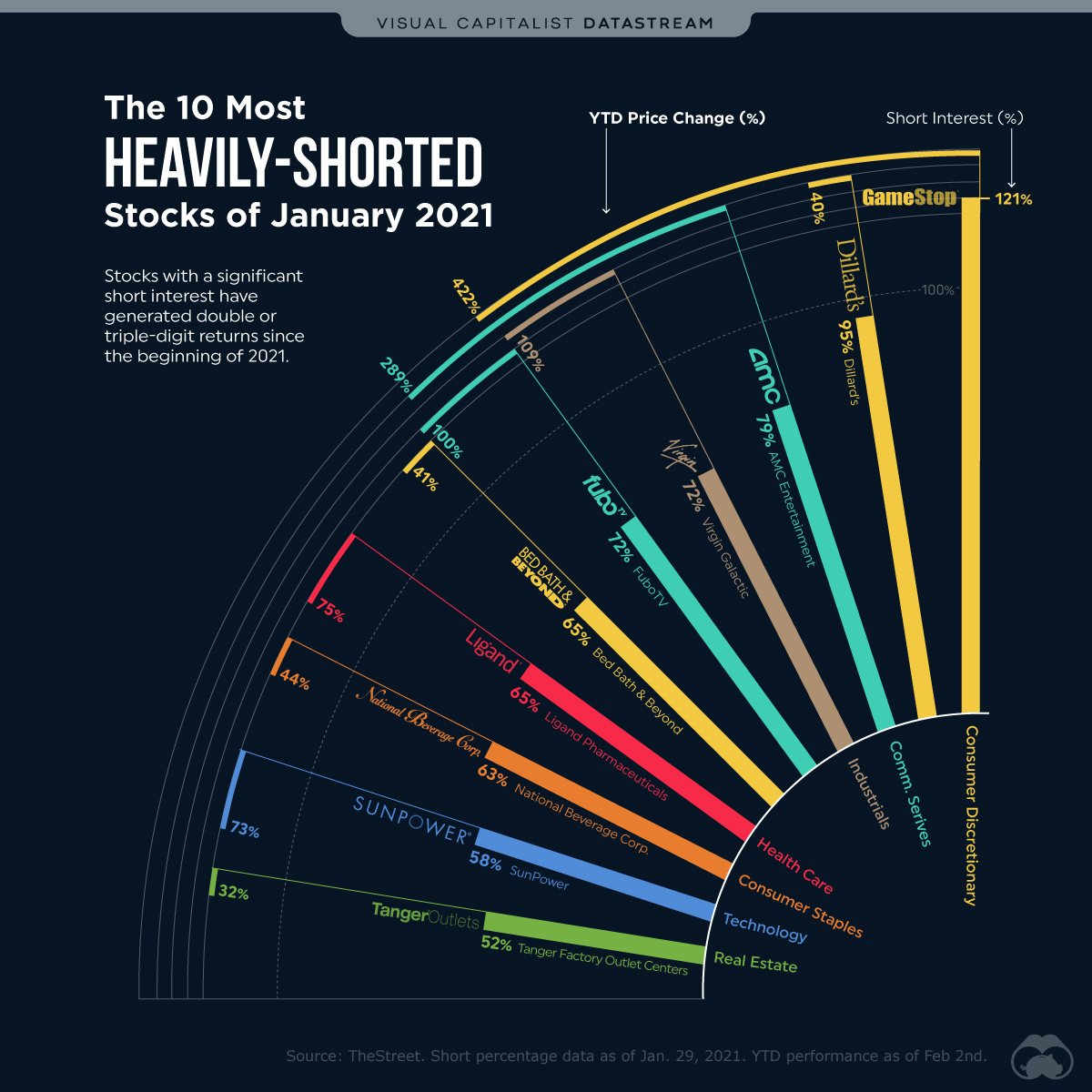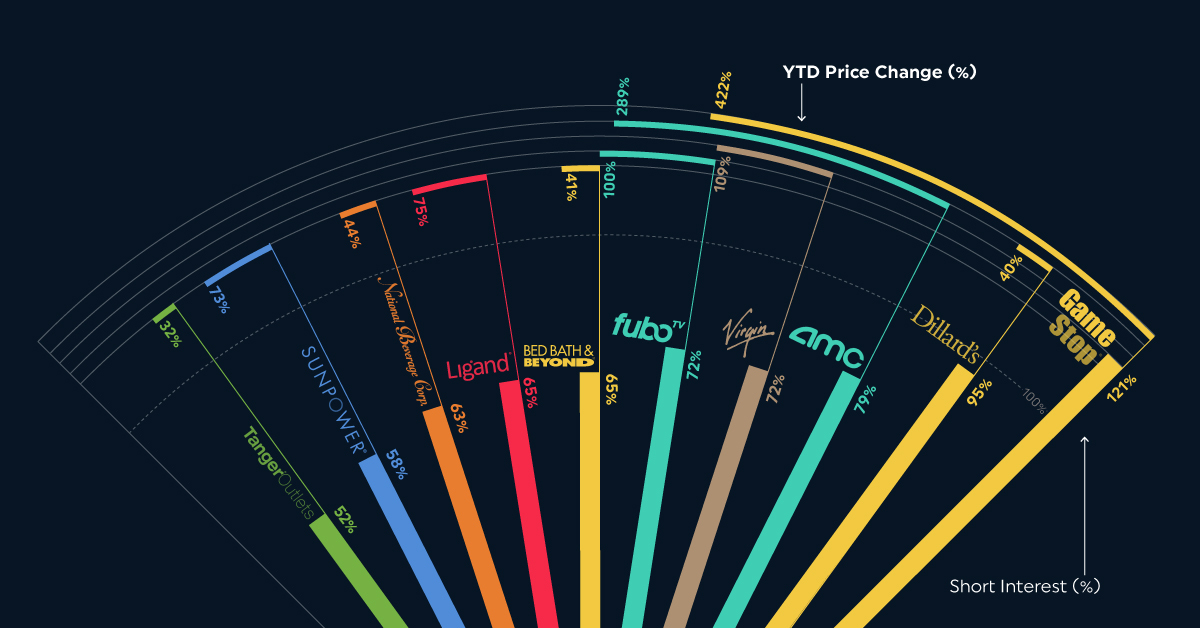Datastream
The 10 Most Heavily-Shorted Stocks of January 2021

The Briefing
- Retail brands, among others, have been the target of short sellers amidst the COVID-19 pandemic
- Individual investors have rallied behind a number of these stocks in an attempt to force a “short-squeeze”
Short Sellers Look to Profit from Struggling Companies
The prospects of retailers such as GameStop have deteriorated over the course of the COVID-19 pandemic, leading many hedge funds to bet against them by taking short positions.
Shorting a company involves borrowing its shares, selling them at current prices, and then buying them back in the future at what is hopefully a lower price. Essentially, short sellers are betting that the company will underperform in the future.
The 10 Most Heavily-Shorted Stocks of January 2021
The following companies had the highest short interest as of January 29, 2021. Short interest is the % of a company’s shares that have been borrowed and sold, but not yet returned.
| Company | Short Interest (%) | YTD Return (%) | Sector |
|---|---|---|---|
| GameStop | 121% | 422% | Consumer Discretionary |
| Dillards | 95% | 40% | Consumer Discretionary |
| AMC Entertainment | 79% | 289% | Communication Services |
| Virgin Galactic | 72% | 109% | Industrials |
| fuboTV | 72% | 100% | Communication Services |
| Bed Bath & Beyond | 65% | 41% | Consumer Discretionary |
| Ligand Pharmaceuticals | 65% | 75% | Health Care |
| National Beverage Corp. | 63% | 44% | Consumer Staples |
| SunPower | 58% | 73% | Technology |
| Tanger Factory Outlet Centers | 52% | 32% | Real Estate |
Source: YTD returns as of Feb. 2, 2021
Many of the companies on this list are brick-and-mortar based retailers that have struggled to attract business during COVID-19 lockdowns. This includes GameStop, Dillards, Bed Bath & Beyond, and AMC Entertainment, America’s largest operator of movie theatres.
Short sellers have also targeted Tanger Factory Outlet Centers for similar reasons. The mall operator’s revenues fell to $64 million in Q3 2020, a 45% drop from the same quarter in 2019. The expectation that a quarter of U.S. malls will close by 2025 could also be a factor for the company’s high short interest.
Retail Investors Clash with Short Sellers
If these companies are expected to fail, why are their share prices making double, and sometimes triple-digit gains? The answer is a phenomenon known as the “short squeeze”.
In an unprecedented move, retail investors have banded together to buy millions of dollars worth of shares to push these companies’ stock prices up, rather than down.
This has forced short sellers to repurchase the shares that they previously borrowed (and sold) at a much higher price. This places even greater upward pressure on the stock, and can result in the triple-digit gains seen in the case of GameStop.
Where does this data come from?
Source: FactSet
Notes: Short interest data as of January 29, 2020. YTD returns as of Feb. 2, 2021.
Datastream
Can You Calculate Your Daily Carbon Footprint?
Discover how the average person’s carbon footprint impacts the environment and learn how carbon credits can offset your carbon footprint.

The Briefing
- A person’s carbon footprint is substantial, with activities such as food consumption creating as much as 4,500 g of CO₂ emissions daily.
- By purchasing carbon credits from Carbon Streaming Corporation, you can offset your own emissions and fund positive climate action.
Your Everyday Carbon Footprint
While many large businesses and countries have committed to net-zero goals, it is essential to acknowledge that your everyday activities also contribute to global emissions.
In this graphic, sponsored by Carbon Streaming Corporation, we will explore how the choices we make and the products we use have a profound impact on our carbon footprint.
Carbon Emissions by Activity
Here are some of the daily activities and products of the average person and their carbon footprint, according to Clever Carbon.
| Household Activities & Products | CO2 Emissions (g) |
|---|---|
| 💡 Standard Light Bulb (100 watts, four hours) | 172 g |
| 📱 Mobile Phone Use (195 minutes per day)* | 189 g |
| 👕 Washing Machine (0.63 kWh) | 275 g |
| 🔥 Electric Oven (1.56 kWh) | 675 g |
| ♨️ Tumble Dryer (2.5 kWh) | 1,000 g |
| 🧻 Toilet Roll (2 ply) | 1,300 g |
| 🚿 Hot Shower (10 mins) | 2,000 g |
| 🚙 Daily Commute (one hour, by car) | 3,360 g |
| 🍽️ Average Daily Food Consumption (three meals of 600 calories) | 4,500 g |
| *Phone use based on yearly use of 69kg per the source, Reboxed | |
Your choice of transportation plays a crucial role in determining your carbon footprint. For instance, a 15 km daily commute to work on public transport generates an average of 1,464 g of CO₂ emissions. Compared to 3,360 g—twice the volume for a journey the same length by car.
By opting for more sustainable modes of transport, such as cycling, walking, or public transportation, you can significantly reduce your carbon footprint.
Addressing Your Carbon Footprint
One way to compensate for your emissions is by purchasing high-quality carbon credits.
Carbon credits are used to help fund projects that avoid, reduce or remove CO₂ emissions. This includes nature-based solutions such as reforestation and improved forest management, or technology-based solutions such as the production of biochar and carbon capture and storage (CCS).
While carbon credits offer a potential solution for individuals to help reduce global emissions, public awareness remains a significant challenge. A BCG-Patch survey revealed that only 34% of U.S. consumers are familiar with carbon credits, and only 3% have purchased them in the past.
About Carbon Streaming
By financing the creation or expansion of carbon projects, Carbon Streaming Corporation secures the rights to future carbon credits generated by these sustainable projects. You can then purchase these carbon credits to help fund climate solutions around the world and compensate for your own emissions.
Ready to get involved?
>> Learn more about purchasing carbon credits at Carbon Streaming
-

 Energy1 week ago
Energy1 week agoThe World’s Biggest Nuclear Energy Producers
-

 Money2 weeks ago
Money2 weeks agoWhich States Have the Highest Minimum Wage in America?
-

 Technology2 weeks ago
Technology2 weeks agoRanked: Semiconductor Companies by Industry Revenue Share
-

 Markets2 weeks ago
Markets2 weeks agoRanked: The World’s Top Flight Routes, by Revenue
-

 Countries2 weeks ago
Countries2 weeks agoPopulation Projections: The World’s 6 Largest Countries in 2075
-

 Markets2 weeks ago
Markets2 weeks agoThe Top 10 States by Real GDP Growth in 2023
-

 Demographics2 weeks ago
Demographics2 weeks agoThe Smallest Gender Wage Gaps in OECD Countries
-

 United States2 weeks ago
United States2 weeks agoWhere U.S. Inflation Hit the Hardest in March 2024














